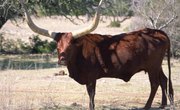Artificial insemination is a scientific fertility treatment in which male sperm is collected and artificially implanted in the female reproductive system as a way to aid conception. On farms, this process is used to control breeding among different farm animals. Artificial insemination in cattle has been used to produce genetically superior dairy cows and animals for meat production.
Animal Artificial Insemination in History
The history of artificial insemination in cattle and other animals date back to ancient time. The University of Florida Institute of Food and Agricultural Sciences (IFAS) Extension states that documents from approximately 1322 A.D. found an Arab chieftain who wanted to mate his prized mare with a stallion owned by an enemy. He used cotton containing the scent of the female to excite the stallion, causing him to ejaculate. He placed the released semen in the reproductive tract of the mare, leading to conception. In the 1780s, Italian naturalist Lazzaro Spallanzani artificially inseminated a dog.
Turn of the Twentieth Century
Around 1899 and 1900, Russian scientist E.I. Ivanoff began conducting artificial insemination on cattle, horses, birds and sheep. He was first person recorded to have accomplished the first successful artificial insemination in cattle. Because Ivanoff was so successful at animal artificial insemination, by 1931, Russia bred approximately 19,800 cows.
Spread of Artificial Insemination
Other countries began researching artificial insemination in cattle throughout the 1930s. In 1936, Denmark founded an artificial insemination association. After his visit to the Denmark facility in 1938, New Jersey native E.J. Perry established the first artificial cooperative at New Jersey State College of Agriculture. In the following two years, seven artificial insemination cooperatives according to the Denmark and New Jersey models appeared in the United States.
The 1940s
In the 1940s, the Bureau of Animal Industry registered the Santa Gertrudis cow, a new breed that represented the direct results of artificial insemination in cattle. Despite this significant breakthrough in cattle breeding, it would take 13 years to improve this process. During that time, scientistd realized that collected bull semen could be saved by placing them in egg solution containing antibiotics and chemicals and freezing it for later use. Pennsylvania and Cornell universities conducted genetic tests in which they learned how to distribute genetic material. Since these universities didn’t patent their processes, other places adopted their techniques of artificial insemination.
Affects on Cattle Industry
Artificial insemination in cattle has had a major impact on the dairy and beef industry, improving productivity and increasing food supply. The University of Florida IFAS Extension says that, in 1970, farmers bred more than 7 million dairy cows. The University of Wisconsin-Madison Animal Science states that cattle farmers use artificial insemination because of four major benefits—genetically superior sires, herd maintenance and disease prevention, reduces need to keep aggressive bulls on farms, and organized breeding and record keeping.
References
Resources
Writer Bio
Based in Tucson, Ariz., Cicely A. Richard has been writing since 1996. Her articles have been published in the “Arizona Daily Star” newspaper and “ForeWord Magazine.” Richard earned Bachelor of Arts degrees in English and journalism from Louisiana State University. .



